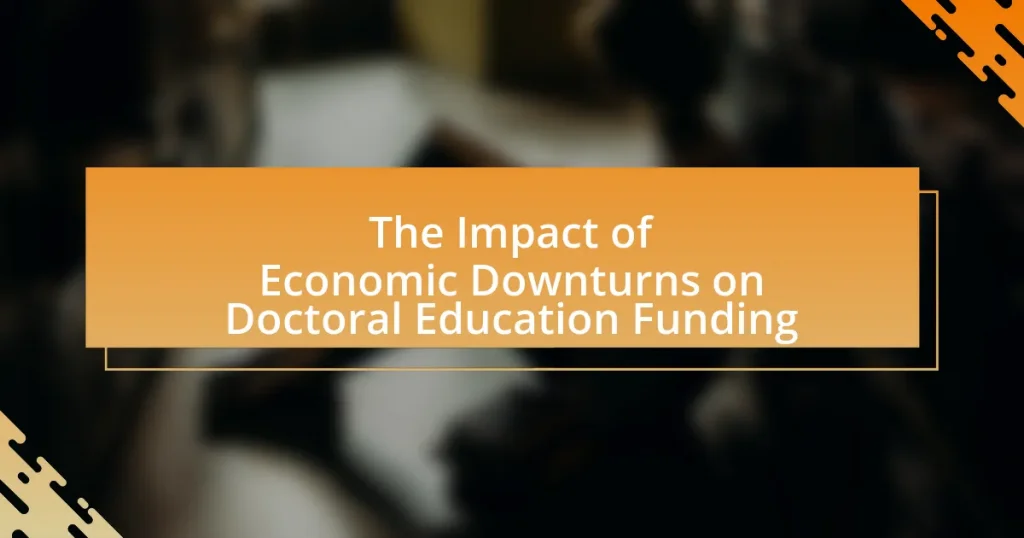The article examines the significant effects of economic downturns on funding for doctoral education, highlighting how reduced state and federal budgets lead to decreased financial support for doctoral programs. It discusses the impact of funding cuts on various sources, including government grants and private donations, which ultimately affect scholarships, assistantships, and research opportunities for doctoral candidates. The article also explores the long-term implications of reduced funding on enrollment, retention, and the quality of doctoral education, as well as the mental health challenges faced by students during economic hardships. Additionally, it outlines strategies that institutions and students can employ to navigate funding challenges and secure financial support during downturns.

What are the effects of economic downturns on doctoral education funding?
Economic downturns significantly reduce funding for doctoral education, primarily due to decreased state and federal budgets. During economic recessions, governments often face budget shortfalls, leading to cuts in higher education funding, which directly impacts doctoral programs. For instance, a study by the National Science Foundation indicated that state funding for higher education dropped by an average of 20% during the 2008 financial crisis, resulting in reduced financial support for graduate students and programs. Additionally, universities may experience lower endowment returns and reduced private donations during downturns, further constraining their ability to fund doctoral education. This combination of factors leads to fewer scholarships, assistantships, and research grants available for doctoral candidates, ultimately affecting enrollment and completion rates in these programs.
How do economic downturns influence funding sources for doctoral education?
Economic downturns significantly reduce funding sources for doctoral education by leading to budget cuts in public institutions and decreased private donations. During economic recessions, government funding for higher education often declines as tax revenues fall, resulting in reduced financial support for doctoral programs. For instance, a study by the National Center for Education Statistics indicated that state funding for higher education decreased by 16% during the 2008 financial crisis, directly impacting doctoral program budgets. Additionally, private foundations and corporations tend to tighten their funding during economic hardships, further limiting available scholarships and grants for doctoral candidates. This combination of reduced public and private funding sources creates a challenging environment for prospective doctoral students seeking financial support.
What types of funding are most affected during economic downturns?
During economic downturns, private funding sources, such as donations and endowments, are most affected. Historical data shows that during the 2008 financial crisis, many universities experienced a significant decline in private donations, with a reported drop of 11.9% in overall giving to higher education institutions. Additionally, government funding often becomes constrained as budget cuts are implemented, leading to reduced grants and financial aid for doctoral programs. This trend was evident in the aftermath of the 2008 crisis, where federal and state funding for education decreased, impacting the availability of resources for doctoral education.
How do changes in government funding impact doctoral programs?
Changes in government funding significantly impact doctoral programs by directly influencing their financial resources and operational capabilities. When government funding decreases, universities often face budget cuts that can lead to reduced stipends for doctoral students, fewer available research grants, and limited faculty hiring. For instance, a study by the Council of Graduate Schools in 2020 indicated that a 10% reduction in state funding correlated with a 15% decrease in doctoral program enrollments. Conversely, increased government funding can enhance program offerings, expand research opportunities, and improve student support services, thereby attracting more candidates to pursue doctoral studies.
Why is doctoral education funding critical during economic downturns?
Doctoral education funding is critical during economic downturns because it ensures the continuation of advanced research and innovation, which are essential for economic recovery. During such periods, funding sources often diminish, yet the need for skilled researchers to address complex societal challenges increases. For instance, the National Science Foundation reported that investment in doctoral education leads to a higher number of graduates who contribute to technological advancements and economic growth. Additionally, historical data shows that during the 2008 financial crisis, universities that maintained funding for doctoral programs were better positioned to recover and innovate, highlighting the importance of sustained investment in higher education during economic hardships.
What role does doctoral education play in economic recovery?
Doctoral education plays a crucial role in economic recovery by fostering innovation and developing a highly skilled workforce. Advanced research conducted by doctoral candidates leads to new technologies and solutions that can stimulate economic growth. For instance, a report from the National Science Foundation indicates that research and development activities associated with doctoral programs contribute significantly to advancements in various industries, enhancing productivity and competitiveness. Furthermore, graduates from doctoral programs often take on leadership roles in academia, industry, and government, driving policy and strategic initiatives that support economic revitalization.
How does funding affect the quality of doctoral education during downturns?
Funding directly impacts the quality of doctoral education during economic downturns by limiting resources available for research, faculty support, and student services. During downturns, universities often face budget cuts, leading to reduced financial aid, fewer faculty positions, and diminished research funding, which collectively hinder the academic experience and outcomes for doctoral students. For instance, a study by the Council of Graduate Schools found that institutions experiencing funding reductions reported a decline in student satisfaction and research opportunities, illustrating the correlation between financial support and educational quality.
What are the long-term implications of reduced funding for doctoral education?
Reduced funding for doctoral education leads to a decline in the quality and accessibility of advanced academic programs. This reduction can result in fewer resources for research, diminished faculty support, and limited opportunities for student funding, which collectively hinder the academic and professional development of doctoral candidates. Historical data indicates that during economic downturns, such as the 2008 financial crisis, universities experienced significant budget cuts, leading to a 20% decrease in doctoral program enrollments in some fields. Consequently, this trend can result in a long-term shortage of qualified professionals in critical areas, ultimately affecting innovation and economic growth.
How does decreased funding affect doctoral student enrollment and retention?
Decreased funding negatively impacts doctoral student enrollment and retention by limiting financial support and resources available to students. When funding is reduced, universities often cut scholarships, assistantships, and other financial aid options, making it more difficult for prospective students to afford tuition and living expenses. For instance, a study by the Council of Graduate Schools found that institutions experiencing budget cuts reported a 15% decline in doctoral applications and a 10% decrease in enrollment rates. Additionally, current students may struggle to continue their studies due to increased financial burdens, leading to higher attrition rates. This correlation between funding and student outcomes highlights the critical role that financial resources play in sustaining doctoral education.
What impact does funding reduction have on research output and innovation?
Funding reduction significantly decreases research output and innovation. When financial resources are limited, research institutions often face constraints that lead to fewer projects being initiated, reduced staffing, and diminished access to necessary materials and technology. A study by the National Science Foundation indicates that a 10% decrease in funding can result in a 20% drop in research productivity, as researchers are unable to pursue new ideas or maintain ongoing projects effectively. Consequently, this decline in funding not only stifles immediate research activities but also hampers long-term innovation, as fewer breakthroughs and advancements emerge from underfunded research environments.

How do institutions adapt to funding challenges during economic downturns?
Institutions adapt to funding challenges during economic downturns by implementing budget cuts, reallocating resources, and seeking alternative funding sources. For instance, universities may reduce administrative expenses and prioritize essential programs to maintain financial stability. Additionally, many institutions increase efforts to secure grants and partnerships with private organizations, which can provide critical financial support. According to a report by the American Council on Education, during the 2008 financial crisis, many universities successfully diversified their funding streams, leading to a more resilient financial structure. This strategic approach allows institutions to navigate economic hardships while continuing to support doctoral education.
What strategies do universities employ to cope with funding cuts?
Universities employ several strategies to cope with funding cuts, including increasing tuition fees, enhancing fundraising efforts, and optimizing operational efficiencies. Increasing tuition fees allows institutions to directly supplement lost revenue; for example, many universities raised undergraduate tuition by an average of 2.4% in the 2021-2022 academic year to counteract budget shortfalls. Enhancing fundraising efforts involves seeking donations from alumni and private donors, which has become crucial as public funding decreases; in 2020, U.S. universities raised over $49 billion through private donations. Additionally, optimizing operational efficiencies includes reducing administrative costs and consolidating programs, which can lead to significant savings; a study by the American Council on Education found that universities could save up to 10% of their budgets through such measures. These strategies collectively help universities maintain financial stability during economic downturns.
How do institutions prioritize funding allocation during financial crises?
Institutions prioritize funding allocation during financial crises by focusing on essential services and programs that ensure operational continuity and student support. During economic downturns, universities often assess their financial health and prioritize funding for critical areas such as student retention, faculty salaries, and essential research projects. For instance, a study by the American Council on Education in 2020 highlighted that institutions redirected funds to support online learning infrastructure and mental health services, recognizing the immediate needs of students and faculty during the pandemic. This strategic reallocation helps institutions maintain their core mission while navigating financial constraints.
What role do partnerships and collaborations play in securing funding?
Partnerships and collaborations significantly enhance the ability to secure funding by pooling resources, expertise, and networks. When institutions or organizations collaborate, they can present a more compelling case to funders by demonstrating a united front and shared goals, which often leads to increased credibility and trust. For instance, collaborative projects can leverage diverse funding sources, such as government grants, private sector investments, and philanthropic contributions, thereby increasing the overall funding potential. Research indicates that collaborative initiatives in education, particularly during economic downturns, can lead to more innovative solutions and efficient use of resources, ultimately attracting more financial support.
How do universities communicate funding challenges to stakeholders?
Universities communicate funding challenges to stakeholders through formal reports, presentations, and direct engagement. These methods include publishing annual financial statements that outline budget constraints, hosting town hall meetings to discuss financial issues, and utilizing newsletters to keep stakeholders informed about funding developments. For example, a 2021 survey by the Association of American Universities indicated that 78% of institutions reported using stakeholder meetings to address financial challenges, demonstrating a proactive approach to transparency and engagement.
What messaging strategies are effective in garnering support for funding?
Effective messaging strategies for garnering support for funding include emphasizing the long-term benefits of investment, utilizing data-driven narratives, and engaging personal stories. Highlighting the return on investment, such as increased employability and innovation, can persuade stakeholders of the value of funding. Data-driven narratives, supported by statistics showing the positive impact of doctoral education on economic growth, enhance credibility. Additionally, personal stories from beneficiaries illustrate the transformative effects of funding, making the case more relatable and compelling. Research indicates that emotional appeals combined with factual evidence significantly increase donor engagement and support.
How can alumni and community engagement help mitigate funding issues?
Alumni and community engagement can significantly mitigate funding issues by fostering financial support and resource sharing. Engaged alumni often contribute through donations, mentorship, and networking opportunities, which can lead to increased funding for doctoral programs. For instance, a study by the Council for Advancement and Support of Education found that institutions with strong alumni relations reported a 20% higher fundraising success rate compared to those with weaker connections. Additionally, community partnerships can provide grants, sponsorships, and collaborative projects that enhance funding avenues. Engaging local businesses and organizations can create a supportive ecosystem that addresses funding challenges during economic downturns.
What innovative funding models emerge during economic downturns?
Innovative funding models that emerge during economic downturns include income share agreements (ISAs), crowdfunding, and public-private partnerships. Income share agreements allow students to receive funding for their education in exchange for a percentage of their future income, which aligns the interests of students and investors. Crowdfunding platforms enable individuals to raise funds directly from the public, often leveraging social media to reach potential backers. Public-private partnerships involve collaboration between government entities and private organizations to finance educational programs, sharing both risks and rewards. These models have gained traction as traditional funding sources, such as grants and loans, become more limited during economic crises, demonstrating adaptability in funding strategies for doctoral education.
How do crowdfunding and alternative financing options support doctoral education?
Crowdfunding and alternative financing options support doctoral education by providing additional financial resources that can alleviate the burden of traditional funding sources. These methods enable doctoral candidates to raise funds directly from a broad audience, often through online platforms, which can be particularly beneficial during economic downturns when institutional funding may be limited. For instance, a study by the University of California found that 30% of graduate students reported using crowdfunding to finance their education, highlighting its growing role as a viable funding strategy. Additionally, alternative financing options, such as income-share agreements, allow students to pay for their education based on future earnings, thus reducing immediate financial pressure and making doctoral programs more accessible.
What lessons can be learned from institutions that successfully navigate funding challenges?
Institutions that successfully navigate funding challenges demonstrate the importance of diversifying revenue streams. By securing funding from multiple sources such as grants, private donations, and partnerships, these institutions reduce reliance on any single funding source, which mitigates risk during economic downturns. For example, universities that have established strong relationships with industry partners often benefit from collaborative research funding, which can provide financial stability even when state or federal funding decreases. Additionally, successful institutions prioritize transparent communication with stakeholders about financial needs and challenges, fostering a culture of support and engagement that can lead to increased donations and community backing. This approach is evidenced by the University of California system, which has effectively utilized public-private partnerships to enhance its funding resilience.

What are the specific impacts of economic downturns on doctoral students?
Economic downturns significantly impact doctoral students by reducing funding opportunities and increasing financial stress. During economic recessions, universities often face budget cuts, leading to fewer available assistantships, scholarships, and grants for doctoral candidates. For instance, a study by the National Science Foundation in 2020 indicated that funding for graduate education decreased by 15% during economic downturns, directly affecting students’ ability to finance their studies. Additionally, doctoral students may experience heightened competition for limited resources, resulting in delays in their research and graduation timelines. The financial strain can also lead to increased reliance on loans, which may exacerbate long-term debt issues for these students.
How do economic downturns affect doctoral student financial aid and scholarships?
Economic downturns typically lead to reduced financial aid and scholarship availability for doctoral students. During such periods, universities often face budget cuts, resulting in fewer resources allocated for graduate funding. For instance, a study by the National Bureau of Economic Research indicates that economic recessions correlate with a decline in state funding for higher education, which directly impacts the financial aid packages offered to students. Additionally, private funding sources may also tighten their budgets, further limiting scholarship opportunities. Consequently, doctoral students may experience increased financial strain and a greater reliance on loans during economic downturns.
What changes occur in the availability of assistantships and fellowships?
The availability of assistantships and fellowships typically decreases during economic downturns. Economic challenges often lead universities to reduce funding for graduate programs, resulting in fewer assistantship and fellowship opportunities. For instance, a study by the Council of Graduate Schools in 2020 indicated that 40% of institutions reported a decline in funding for graduate assistantships due to budget cuts linked to economic pressures. This reduction directly impacts the financial support available to doctoral students, making it more difficult for them to secure necessary funding for their education.
How do students adapt to increased financial pressures during downturns?
Students adapt to increased financial pressures during downturns by seeking additional funding sources, reducing expenses, and altering their academic plans. Many students apply for scholarships, grants, or part-time jobs to supplement their income, which is crucial during economic instability. Research indicates that during the 2008 financial crisis, a significant number of graduate students reported taking on more work hours or shifting to less expensive living arrangements to manage their finances effectively. Additionally, some students may extend their study duration to balance work and academic commitments, thereby alleviating immediate financial strain while still pursuing their educational goals.
What mental health challenges do doctoral students face during economic downturns?
Doctoral students face increased mental health challenges during economic downturns, primarily due to financial stress, uncertainty about future employment, and reduced funding opportunities. Financial stress can lead to anxiety and depression, as students may struggle to cover tuition and living expenses. Research indicates that during economic recessions, graduate students report higher levels of psychological distress, with a study by the American Psychological Association showing that financial concerns significantly correlate with mental health issues among this demographic. Additionally, the fear of job scarcity post-graduation exacerbates feelings of inadequacy and hopelessness, further impacting their mental well-being.
How does financial stress impact academic performance and well-being?
Financial stress negatively impacts academic performance and well-being by causing distractions, reducing focus, and increasing anxiety among students. Research indicates that students experiencing financial difficulties often report lower grades and higher dropout rates, as financial concerns can lead to decreased motivation and engagement in their studies. A study published in the Journal of Student Financial Aid found that 70% of students facing financial stress experienced significant academic challenges, including lower GPAs and increased absenteeism. Additionally, financial stress is linked to mental health issues, such as depression and anxiety, which further hinder academic success and overall well-being.
What resources are available to support doctoral students during tough economic times?
Doctoral students can access several resources during tough economic times, including university financial aid offices, emergency grants, and mental health services. Many universities offer specific emergency funds to assist students facing financial hardships, which can cover tuition, living expenses, or unexpected costs. Additionally, federal and state financial aid programs, such as Pell Grants and subsidized loans, remain available to eligible students. Academic institutions often provide counseling services to support mental well-being, which is crucial during economic stress. Furthermore, professional organizations and academic associations may offer scholarships or fellowships aimed at supporting doctoral candidates in need.
What practical steps can doctoral students take to secure funding during downturns?
Doctoral students can secure funding during downturns by diversifying their funding sources and actively seeking alternative financial support. This includes applying for grants from government agencies, private foundations, and non-profit organizations that specifically support research and education, as many of these entities increase funding during economic challenges. Additionally, students should consider part-time teaching or research assistant positions within their institutions, as universities often maintain these roles even in downturns. Networking with faculty and industry professionals can also uncover hidden funding opportunities, as personal connections may lead to scholarships or project funding. Furthermore, students should stay informed about emergency funding programs that universities may establish in response to economic crises, ensuring they apply promptly to benefit from these resources.
How can students effectively seek out alternative funding opportunities?
Students can effectively seek out alternative funding opportunities by researching various sources such as scholarships, grants, and fellowships specifically designed for doctoral education. Many universities and organizations offer funding options that are not widely advertised, so students should utilize academic networks, attend workshops, and consult with faculty advisors to uncover these resources. For instance, the National Science Foundation provides grants for doctoral students in STEM fields, while the Fulbright Program offers international research opportunities. Engaging with online platforms like ProFellow or Fastweb can also help students identify funding tailored to their specific research interests and backgrounds.
What strategies can students use to manage their finances during economic challenges?
Students can manage their finances during economic challenges by creating a detailed budget, prioritizing essential expenses, and seeking additional sources of income. A budget helps students track their income and expenses, ensuring they allocate funds effectively. Prioritizing essential expenses, such as tuition and housing, allows students to focus on what is necessary for their education and living situation. Additionally, seeking part-time work, freelance opportunities, or scholarships can provide extra financial support. According to a report by the National Center for Education Statistics, students who actively manage their finances are more likely to complete their degrees without incurring excessive debt.



